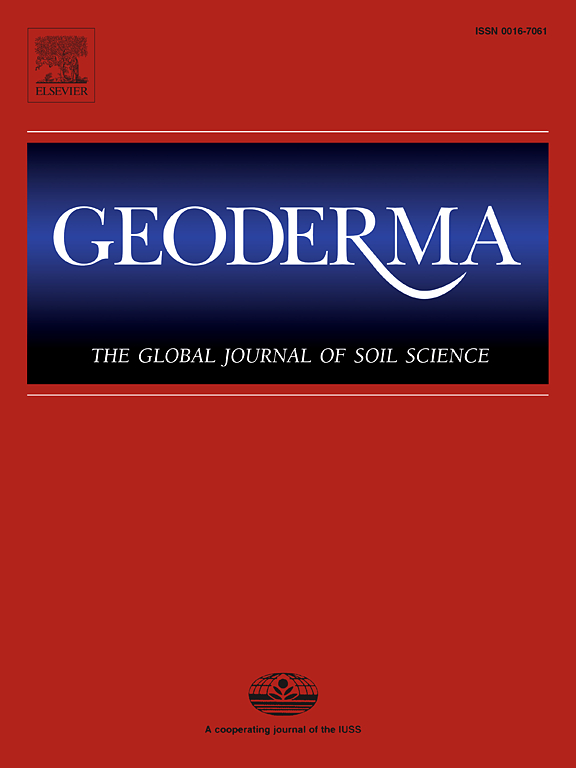Nitrogen and phosphorus fertilizer use efficiency: the interactive effects of fertilization and liming
IF 6.6
1区 农林科学
Q1 SOIL SCIENCE
引用次数: 0
Abstract
Nitrogen (N) and phosphorus (P) play important roles in increasing agricultural productivity. However, excessive use of N and P fertilization can result in low N and P fertilizer use efficiencies (REN and REP) and loss of N and P through gaseous emission and leaching, but which also depend on soil pH conditions. In a full factorial glasshouse experiment using pots with 2.5 kg soil and adding N (0 and 100 kg N ha−1), P (0 and 50 kg P ha−1) fertilizer and lime (0, 3.5, 14 t ha−1, 100 % calcium carbonate equivalent) we investigated the main and interactive effects of our treatments on REN and REP in wheat (Triticum aestivum) grown in a P-poor soil. The REN was close to zero without P fertilization regardless of liming, but increased to 46 % with P fertilization (averaged across liming treatment) because of strong P limitation. Likewise, N fertilization increased REP from 6 % to 8 % averaged across the liming treatment. However, liming decreased REN (only when P fertilizer was added), possibly because of enhanced net N mineralization in the soil making plants less dependent on N fertilizer with liming, and increased REP, possibly because of reduced fertilizer P-immobilization in the soil with low pH. Overall, N and P fertilizer and lime addition changed REN and REP by changing wheat growth along with N and P uptake, thereby affecting soil available nutrients, nitrous oxide emissions and N and P loss through leaching. We highlight the importance of adjusting N and P fertilization with liming to optimize REN and REP and reduce N and P loss.

氮磷肥利用效率:施肥与石灰的交互效应
氮(N)和磷(P)在提高农业生产力中起着重要作用。然而,过量施用氮磷肥会导致氮磷肥利用效率低(REN和REP),并通过气体排放和淋滤损失氮和磷,但这也取决于土壤pH条件。在一个全因子温室试验中,我们研究了在磷贫瘠土壤中生长的小麦(Triticum aestivum)的REN和REP的主要影响和交互作用,在盆栽中施用2.5 kg土壤,并添加N(0和100 kg N ha−1),P(0和50 kg P ha−1)肥和石灰(0、3.5、14 t ha−1,100%碳酸钙等量)。在不施磷肥和不施磷肥的情况下,土壤养分利用率接近于零,而施磷肥后,土壤养分利用率提高到46%(各施磷肥处理的平均值)。同样,在石灰处理期间,施氮可使土壤的平均回收率从6%提高到8%。石灰化降低了REN(仅在添加磷肥时),这可能是因为石灰化增强了土壤的净氮矿化,使植物对氮肥的依赖性降低;石灰化增加了REP,这可能是由于低ph土壤中肥料磷素的固定减少。总体而言,氮磷肥和石灰添加通过改变小麦生长和氮磷吸收,从而影响土壤速效养分,从而改变了REN和REP。一氧化二氮的排放和氮磷的淋失。强调了通过限制氮磷肥的施用来优化氮磷素和土壤再利用率,减少氮磷素损失的重要性。
本文章由计算机程序翻译,如有差异,请以英文原文为准。
求助全文
约1分钟内获得全文
求助全文
来源期刊

Geoderma
农林科学-土壤科学
CiteScore
11.80
自引率
6.60%
发文量
597
审稿时长
58 days
期刊介绍:
Geoderma - the global journal of soil science - welcomes authors, readers and soil research from all parts of the world, encourages worldwide soil studies, and embraces all aspects of soil science and its associated pedagogy. The journal particularly welcomes interdisciplinary work focusing on dynamic soil processes and functions across space and time.
 求助内容:
求助内容: 应助结果提醒方式:
应助结果提醒方式:


